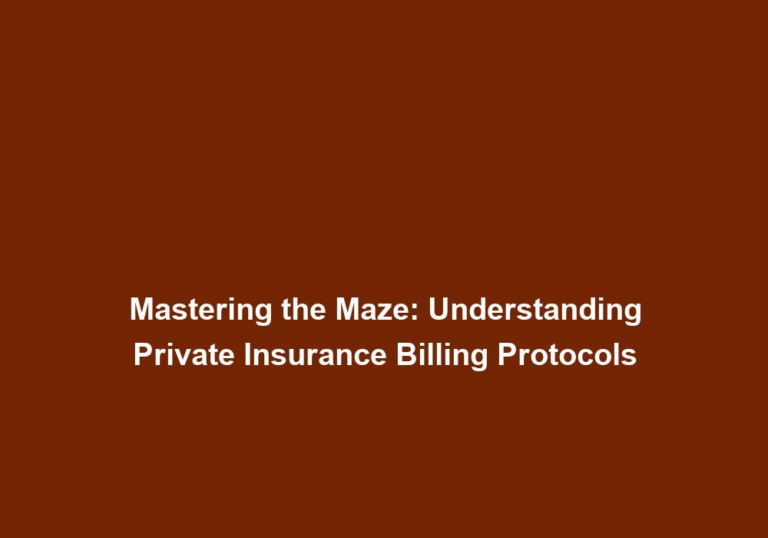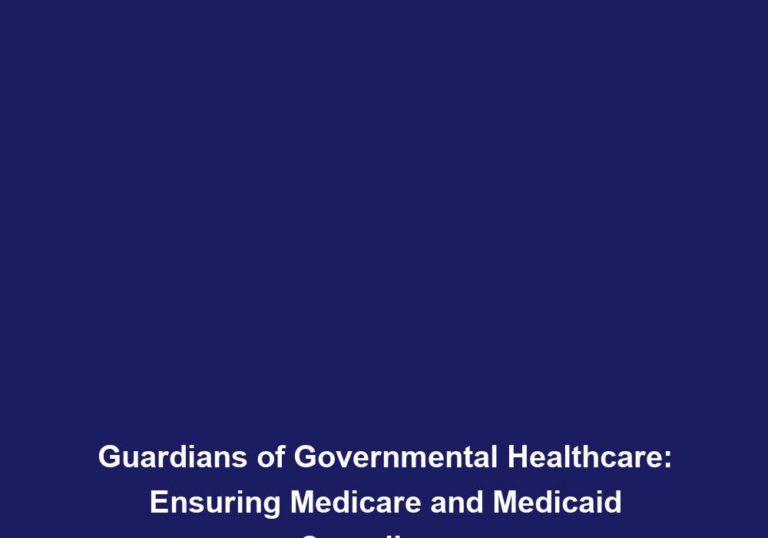The ABCs of Governmental Healthcare: An Overview of Medicare and Medicaid Compliance
In the complex world of healthcare, it is crucial for providers, patients, and all stakeholders to have a comprehensive understanding of governmental healthcare programs. Two prominent programs that play a vital role in ensuring access to healthcare for eligible individuals are Medicare and Medicaid.
What is Medicare?
Medicare is a federal health insurance program primarily designed for individuals who are 65 years or older. It also covers younger people with disabilities and those with end-stage renal disease. Administered by the Centers for Medicare & Medicaid Services (CMS), Medicare is divided into several parts, each covering different services:
Medicare Part A: Hospital Insurance
Medicare Part A provides coverage for inpatient hospital stays, skilled nursing facility care, hospice care, and some home health care services. Beneficiaries typically do not have to pay a premium for Part A if they or their spouse have paid Medicare taxes while working.
Expanding on this, Medicare Part A is often referred to as “Hospital Insurance” because it primarily covers services related to hospital stays. This includes inpatient care, where patients are admitted to a hospital for treatment or surgery. It also includes care received in a skilled nursing facility, which provides specialized care for individuals recovering from an illness or injury. Additionally, Part A covers hospice care for individuals with a terminal illness and some home health care services.
Medicare Part B: Medical Insurance
Medicare Part B covers medically necessary services, including doctor’s visits, outpatient care, preventive services, and durable medical equipment. Beneficiaries are required to pay a monthly premium for Part B coverage, and there may be additional out-of-pocket costs such as deductibles and coinsurance.
To further elaborate, Medicare Part B, also known as “Medical Insurance,” covers services that are typically provided outside of a hospital setting. This includes visits to doctors’ offices, outpatient care received in clinics or ambulatory surgical centers, preventive services like vaccinations and screenings, and durable medical equipment such as wheelchairs or oxygen supplies. Beneficiaries are responsible for paying a monthly premium for Part B coverage, and they may also have to meet a deductible before Medicare begins to pay its share of the costs.
Medicare Part C: Medicare Advantage
Medicare Part C, also known as Medicare Advantage, offers an alternative way to receive Medicare benefits through private insurance companies approved by Medicare. These plans often include additional benefits such as prescription drug coverage, dental and vision services, and wellness programs.
Expanding on this, Medicare Part C, or “Medicare Advantage,” allows beneficiaries to receive their Medicare benefits through private insurance companies. These plans must provide at least the same level of coverage as Original Medicare (Parts A and B), but they often offer additional benefits that Original Medicare does not cover. These can include prescription drug coverage, dental and vision services, hearing aids, and even fitness programs. Medicare Advantage plans may also have different cost-sharing arrangements, such as copayments or coinsurance, and they may require beneficiaries to use a network of doctors and hospitals.
Medicare Part D: Prescription Drug Coverage
Medicare Part D provides prescription drug coverage to Medicare beneficiaries. Offered through private insurance companies, Part D plans help individuals afford necessary medications. Beneficiaries can choose a standalone Part D plan or opt for a Medicare Advantage plan that includes prescription drug coverage.
To provide further insight, Medicare Part D focuses specifically on prescription drug coverage. This is important because Medicare Part A and Part B do not typically cover prescription medications, so beneficiaries must enroll in a separate Part D plan to receive this coverage. Part D plans are offered by private insurance companies that have contracts with Medicare. These plans vary in terms of the medications they cover, the costs associated with those medications (such as copayments or coinsurance), and the pharmacies that can be used. Beneficiaries can choose a standalone Part D plan to work alongside Original Medicare or select a Medicare Advantage plan that includes prescription drug coverage.
What is Medicaid?
Medicaid, on the other hand, is a joint federal and state program that provides health coverage to low-income individuals and families. While the federal government sets certain guidelines, each state has some flexibility in determining eligibility requirements and specific benefits provided.
Expanding on this, Medicaid is a program that is jointly funded by the federal government and individual states. Its primary purpose is to provide health coverage to individuals and families with limited income and resources. While the federal government sets some basic guidelines for Medicaid eligibility, each state has the flexibility to establish its own eligibility criteria and determine the specific benefits offered. This means that eligibility requirements and covered services can vary from state to state.
Medicaid eligibility primarily relies on income level, but other factors such as age, disability, and family size may also be considered. Benefits vary from state to state, but common services covered by Medicaid include doctor’s visits, hospital stays, long-term care, prescription drugs, and preventive care.
To provide a more detailed understanding, Medicaid eligibility is primarily based on income level. Generally, individuals and families with incomes below a certain threshold are eligible for Medicaid coverage. However, there are also other factors that can impact eligibility, such as age, disability, and family size. For example, children from low-income families may be eligible for Medicaid regardless of their parents’ income. Pregnant women, individuals with disabilities, and seniors may also qualify for Medicaid based on specific criteria.
The specific benefits provided by Medicaid vary from state to state, but there are some common services that are typically covered. These include doctor’s visits, hospital stays, and emergency care. Medicaid also covers long-term care services, such as nursing home care or home health services, for individuals who meet the eligibility criteria. Prescription drugs are also covered by Medicaid, ensuring that beneficiaries have access to necessary medications. Additionally, Medicaid emphasizes preventive care, covering services like vaccinations, screenings, and wellness visits to help individuals stay healthy and detect potential health issues early on.
Compliance Requirements for Medicare and Medicaid Providers
To participate in Medicare and Medicaid programs, healthcare providers must meet specific compliance requirements. These requirements aim to ensure that taxpayer dollars are used appropriately, and beneficiaries receive high-quality care. Here are some essential compliance considerations for providers:
Enrollment and Credentialing
Providers must enroll in the Medicare and Medicaid programs before they can bill for services provided to eligible beneficiaries. Enrollment involves completing an application process and meeting certain criteria, such as appropriate licensure and adherence to program rules and regulations.
Enrollment and credentialing are critical steps for healthcare providers to become eligible to participate in Medicare and Medicaid programs. Providers must go through an application process and provide necessary documentation to demonstrate their qualifications and compliance with program requirements. This includes verifying appropriate licensure, certifications, and accreditations. The enrollment process helps ensure that providers meet the necessary standards to deliver quality care to Medicare and Medicaid beneficiaries.
Claims Submission and Coding
Accurate claims submission and coding are crucial for Medicare and Medicaid reimbursement. Providers must follow specific coding guidelines, such as using the International Classification of Diseases (ICD) codes, Current Procedural Terminology (CPT) codes, and Healthcare Common Procedure Coding System (HCPCS) codes.
Claims submission and coding play a vital role in the reimbursement process for healthcare providers participating in Medicare and Medicaid programs. It is essential for providers to accurately document and code the services they provide to ensure proper reimbursement. This involves using standardized code sets, such as ICD codes for diagnoses, CPT codes for procedures, and HCPCS codes for durable medical equipment and supplies. By following these coding guidelines, providers can communicate the specific services rendered to the payer, facilitating accurate billing and reimbursement.
Fraud, Waste, and Abuse Prevention
Medicare and Medicaid have robust fraud, waste, and abuse prevention programs to safeguard program integrity. Providers must educate their staff on proper billing practices, implement internal controls, and promptly report any potential fraudulent activities or billing errors.
Preventing fraud, waste, and abuse is a critical aspect of Medicare and Medicaid compliance. Providers are responsible for ensuring that their billing practices align with program requirements and regulations. This involves educating staff members on proper coding and billing procedures, as well as implementing internal controls to detect and prevent fraudulent activities. Providers should also have mechanisms in place to promptly report any suspected instances of fraud, waste, or abuse to the appropriate authorities. By actively participating in fraud prevention efforts, providers help safeguard the integrity of the Medicare and Medicaid programs.
Documentation and Medical Necessity
Thorough and accurate documentation of patient encounters is vital for Medicare and Medicaid compliance. Providers must ensure that medical records reflect the medical necessity of services provided and support the billed codes. Regular internal audits can help identify any documentation deficiencies and ensure compliance.
Documentation and medical necessity are critical components of Medicare and Medicaid compliance. Providers must maintain thorough and accurate medical records that document the care provided to patients. These records should clearly demonstrate the medical necessity of the services rendered and support the codes billed for reimbursement. Regular internal audits can help identify any documentation deficiencies and ensure that providers are meeting the necessary standards. By maintaining comprehensive and accurate documentation, providers can demonstrate compliance with Medicare and Medicaid requirements.
Compliance Training and Education
Ongoing compliance training and education are critical for healthcare providers participating in Medicare and Medicaid programs. Staff members should receive regular updates on program requirements, coding changes, billing guidelines, and anti-fraud initiatives to remain compliant and avoid penalties.
Compliance training and education are essential for healthcare providers to stay current with the evolving requirements of Medicare and Medicaid programs. It is crucial for staff members to receive regular updates on program regulations, coding changes, billing guidelines, and anti-fraud initiatives. This helps ensure that providers and their staff are aware of their responsibilities and can adapt to any updates or changes in the programs. By investing in ongoing training and education, providers can enhance their compliance efforts and mitigate the risk of penalties or sanctions.
Conclusion
Medicare and Medicaid are essential components of the U.S. healthcare system, providing access to healthcare services for millions of individuals. Understanding the intricacies of these programs and their compliance requirements is essential for healthcare providers to deliver quality care while meeting regulatory obligations.
By enrolling in the programs, adhering to billing and coding guidelines, preventing fraud and abuse, maintaining thorough documentation, and investing in staff education, providers can navigate the complexities of Medicare and Medicaid compliance successfully. Ultimately, ensuring compliance benefits both providers and beneficiaries, contributing to a more efficient and effective healthcare system.






